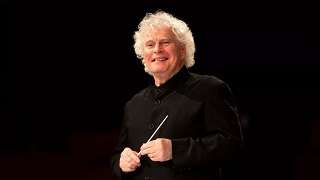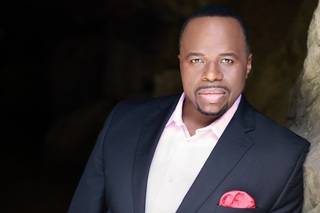|
Back
Shimmy, Slavery and Sledgehammer New York
Isaac Stern Auditorium, Carnegie Hall
05/02/2024 - & April 21 (Frankfurt), 22 (Köln), September 3 (Berlin), 2024
Paul Hindemith: Ragtime (Well-Tempered)
Alexander von Zemlinsky: Symphonische Gesänge, Op. 20
Gustav Mahler: Symphony No. 6 in A Minor
Lester Lynch (Bass-Baritone)
Bavarian Radio Symphony Orchestra, Sir Simon Rattle (Chief Conductor)

Sir S. Rattle (© Astrid Ackermann)
“Ultimately, the debate around race is one America cannot escape–it is built into our history and baked into all parts of our society.”
Bass-baritone Lester Lynch, in notes about Symphonische Gesänge
“My ‘Sixth’ will propound riddles the solution of which may be attempted only by a generation which has absorbed and truly digested my first five symphonies.”
Rarely has an audience in Carnegie Hall broken into such sustained and admiring applause, when Sir Simon Rattle appeared on stage with his Bavarian Radio Symphony Orchestra. The one‑time wunderkind is now 69 years old, but that so distinctive mane of white hair hasn’t changed, his confident surefire conducting (mostly without score) and his choices for a visiting German ensemble were always interesting.
Actually more than interesting. The first two pieces are more than rare, both of them influenced by another generation of African Americans.
To those who know Paul Hindemith’s later so‑serious chamber and orchestral works, they forget his Weimar Republic mirth, satire, pastiche and Weill‑like acidity. His Ragtime (Well‑Tempered) was based on Bach’s C Minor Fugue, and it was a relatively rollicking three‑minutes. No, the echt-German never had the freedom of Milhaud or Stravinsky, but it was a happy prelude to the more serious program.
Until last night I had heard a single work by Alexander von Zemlinsky, The Dwarf at the Paris Opera. It was difficult, atonal, not (to my ears) terribly interesting. (More interesting was how an Austrian Jew got a “Von” attached to his name.) His work last night, Symphonic Songs, was a unique black-and-white medley. The songs, which he composed while a refugee in New York, were based on African-American themes. But they were not based on so‑called spirituals. Nor was the music based on African-American blues or jazz or syncopated melodies.
The poems, written by urbane writers like Langston Hughes and Countee Cullen, dealt with lynching, death, disillusion, crime. Translated and sung in German, they lost some of the original power, but were fiercely lyrical.
The music was percussive or brassy at times. In all, they resembled Mahler’s quasi‑folk songs from The Youth’s Magic Horn. But they were far from simple, verging on the atonal.

L. Lynch (© Rex Lott)
Bass-baritone Lester Lynch was a commanding presence with a commanding voice. Musically, he could emulate the cotton-balers in Jean Toomer’s poem. In Langston Hughes’ work, he seriously sung “Grollen die Tom‑toms/Rollen die Tom‑toms” with the rhythm of the “Afrikanischer Tanz”.
The opening “Song for a Black Girl”, describing a lynching, was translated “Lied aus Dixieland”. The irony was superfluous. The music began percussively, ending oh‑so softly with violas and cellos, ending with two solo violins and solo cello. Almost unbearably agonizing.
More important was how Mr. Lynch overcame the loud, almost ferocious orchestral parts, his enunciation was perfectly clear–and the attitude was a near uncontrolled ferocity.
A true shame that this unique work by Schoenberg’s student is rarely played, but hugely effective, both in words and music.
That first half was a mere 20 minutes. Mahler’s A Minor Sixth Symphony was four times that length. Some of us were waiting for the sledgehammer finale–but that was wrong. Sir Simon started off with a rushing pulsing start–much faster than usual–and he never let go!
This was a ferocious start and the 75‑year-old orchestra was primed for the task. No striving for glamor, no extra crescendos for the infinite climaxes. Violins weren’t clumped together but split left and right. Percussion was equally grouped. Brass–especially the low trombones and tuba–growled or lamented, the flute solo was touching.
And when four cymbal players lifted their instruments together across the stage it was Cecil B. DeMille epochal.
After that first ear-splitting, nervous quick-marching pace, conductor Rattle continued with the Andante (against Mahler’s direction to place it third). Sir Simon produced some of the most beautiful elegiac (and almost oriental) themes here for strings and solo horn.
The scherzo was less a joke than a return to the martial opening, and leading inevitably to the “tragic” (a surname for the symphony) finale. The duration of a Haydn symphony, this Allegro moderato allowed the maestro to return to the start, breathing high‑voltage energy into the marches, softening the chorales and preparing some of us to the sledgehammer.
Specifically, the ffff thwacks of the drums with what looked like a sledgehammer. Mahler varied from two to three thwacks in different editions. I could have watched those blows a dozen times, but Sir Simon kept them down to two.
No problem. Nothing in this Sixth Symphony was pleasant or comforting. It held me and the audience by the throats and yanked the emotions out of us. A thrilling performance by a still thrilling conductor.
Harry Rolnick
|